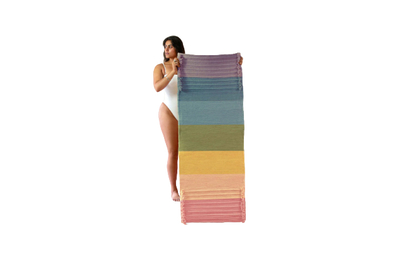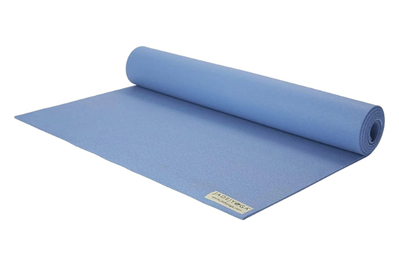Top pick
Woven-cotton yoga mats, otherwise known as yoga rugs, are known for challenging practitioners who have previously practiced only on rubber or PVC. That’s because woven mats are typically more slippery, except when wet. (The cotton absorbs moisture, adding to the mat’s grip when you sweat.) By contrast, PVC mats, Oko Living states, allow you to rely on friction for stability, rather than achieving that by engaging your core and other muscle groups.
Oko Living is not the only seller of such mats. In fact, JadeYoga also makes a yoga rug. But the Oko Living mat looked especially pretty, and its distinct tufted horizontal ridges running across the top and bottom made it easy to spot in my feed. I even noticed it a few times in the background of reposts by teachers I follow, not in my immediate yoga circle, but just beyond.
I am a grump when it comes to ads. Still, eventually, Oko Living got me. I clicked through and learned that the mat costs nearly $190.
The JadeYoga Harmony, a natural-rubber mat that’s Wirecutter’s top yoga mat pick, costs a few bucks shy of $100—not cheap, either. (JadeYoga’s yoga rug, though, is half the price of Oko Living’s at $90.)
But sometimes you pay for craft as much as for materials and quality; Oko Living suggests that its handwoven, organic-cotton mat can last a lifetime. Plus, you can machine-wash it and air-dry it, unlike an all-rubber mat. Intrigued, I ordered one for testing.

When the mat arrived at my door, one thing was immediately clear: It really is beautiful. The indigo moon colorway is a pale but incandescent blue, like well-loved jeans or a dusty sky. The GOTS-certified organic-cotton yarn, especially the tufts, feels brushed and soft to the touch, and the weave is tight and high-quality. I would be proud to use this mat as a rug in my home.
In testing, the mat stayed in place, thanks to its natural-rubber-coated underside. But the first two times I tried it, I found my feet sliding back in that most repeated asana, downward dog. The rug’s woven “ribs”—the raised stripes that are more or less where your hands and feet tend to land in a down dog—are meant to aid in grip. But they did not prevent my feet from sliding back, and I found myself rounded slightly out of an ideal dog shape, tensing to stay put. Twice, I bailed midway through practice and unrolled my rubber mat. Afterward, I felt an unusual twinge in my back and was glad that I’d listened to my body and swapped out.
The company states that the mat gets grippier “as you sweat.” I did not sweat while testing, so to compensate, before my third test, I followed the company’s suggestion to lightly spray the mat with water on and around the ribbing. This noticeably improved the grip when my hands and feet were planted at plank distance, enough for me to complete a 20-minute practice. But for seated postures where I still wanted some resistance, I had to sit on the ridges, which wasn’t especially comfortable.
The rug stretches a bit when you’re in certain poses, reinforcing the oppositional action of, say, one leg anchoring backward and the other leg driving forward, a dynamism that some people might view as a bonus. For my hypermobile body, this enabled overstretching in certain postures.
The Oko Living mat is available in three thicknesses. I chose the middle thickness, 5 mm, and was surprised to find that I wanted more padding. I usually prefer a relatively thin-profile natural-rubber mat to a pillowy sticky mat. If you are accustomed to a plusher mat, or if you use a blanket for cushioning your knees, elbows, and other joints, definitely consider the 7 mm version.
While the Oko Living yoga rug is beautiful, I believe it’s mainly appropriate for an experienced practitioner, particularly one without hypermobility who doesn’t want to use their mat for other types of training, such as interval training or Pilates, and who uses yoga blocks primarily for restorative postures rather than for balance or accessibility. (The rug’s material and ribs contributed to some rockiness with my blocks, especially on their highest height.)
To be fair, I did not test the rug long-term. And I may simply not be the ideal person for this mat style. I haven’t used a sticky mat in over a decade, and I’ve benefited from yoga and Pilates teachers whose anatomy-forward cues taught me how to safely engage my muscles to build strength and protect my joints. I’ve also done multiple yoga-teacher trainings, including a 200-hour teaching-certificate program, so while I’m always learning new things about my body, I can already tell when I’m actively in a pose.
Additionally, getting the yoga rug damp every day is unappealing to me, but using it dry, while perspective-shifting, made my nearly-40-year-old body feel junky, and I worried about injury.
In retrospect, trying out a yoga rug cemented a central tenet of yoga teaching for me: Discernment is central to yoga, and what’s right for one person may not be right for you. Mat preference is personal—you should use the mat that supports the experience you want to have on the mat and that makes you feel safe.
I have hypermobile joints, so I want a little help with stability to get those isometric holds. My proportions and my 5-foot-4 height might not be ideal for the placement of the ribbing. And my relatively low-intensity, blended, block-heavy, nonlinear practice—which includes switching orientation on the mat, using the mat for dynamic stretching, and incorporating Pilates, interval, and mobility training—seems ill-suited to the Oko Living rug, whose rib placement often felt overly deterministic to me. If any of that applies to you too, you may want to look elsewhere.
To its credit, Oko Living, a small business, expects that the mat will take some getting used to and may not be for everyone. It offers a full refund within 30 days, so if you’re curious, and don’t mind paying for return shipping, it might be worth a shot. If you have a woven-cotton rug at home, you might also try laying it over a sticky mat to see if you like the feel.
I did find it pleasant to sit on the mat and do gentle floor stretches and twists. On Oko Living’s FAQ page, the company states that the mat is “especially amazing for restorative or meditative yogas.” If your primary practice is restorative yoga and seated or supine meditation, or if you frequent hot-yoga studios or don’t mind getting the mat damp each time you practice, you may consider the Oko Living rug an upgrade.
Honestly, if the Oko Living yoga rug is right for you, I am jealous—as I said, this mat is beautiful. And it does live up to its promises: It is suitable for more advanced practitioners, it does get easier to grip when wet, and it is challenging to use. Unfortunately, for my body, it just wasn’t the right fit.
This article was edited by Hannah Rimm and Maxine Builder.






